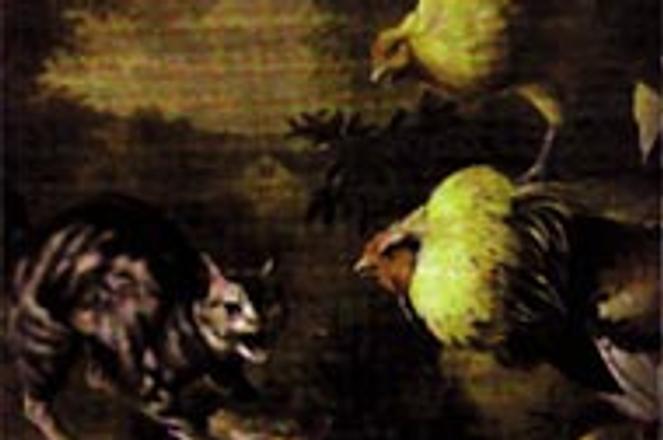Cat attacking poultry(1706 - 1710) by Jakub Bogdan. The painter left Slovakia with his parents for religious reasons studying art in Holland. Many of his paintings were popular with the Royal family in Great Britain.
With the mere mention of the word "gallery", one tends to imagine wading through scores of senior citizens, passing boring art and overhearing dreary conversation consisting of "profound" observations. Besides, actors performing in a theater or musicians playing a concert are infinitely more animate and easier to relate to than a pale piece of art or an armless and lifeless statue. This conviction is, simply put, not true.
The Slovak National Gallery (SNG) is trying to change this way of thinking by hosting a variety of exhibitions, many of which appeal to a younger generation. With the introduction of more contemporary artists, music programs and even a hip new cafe, they hope to attract a new breed of gallery-goers. In the four-story maze of rooms and halls, there are a number of featured exhibits, as well as three permanent exhibits to enjoy; each of which generally progress in reverse time-order as you walk through the gallery.
Baroque
The exhibition titled "Baroque Art in Slovakia" features pieces from the late Renaissance and Baroque periods in Slovakia. Religious figurines without arms, painted portraits of the dead, and Messerschmidt's famous black busts of extraordinary facial expressions are on display.
Mother (1933). One of the most famous Slovak paintings by Mikuláš Galanda who hadn't found himself until as he said, "like a seaman who has made a journey around the world and suddenly realizes the beauty of his native country."
There are also several beautiful fresco-style pieces painted by an unknown Central European painter in the 18th century. Many of the fine works are a result of painstaking restoration work, since many of the works were bought in horrible condition in the 1960's and 70's. The SNG devotes two halls and corridors to this collection aiming to show the early development of art on the Slovak territory.
Gothic
Progressing slightly back in time to the "Gothic Art in Slovakia" exhibition, this period is highlighted by colorful paintings of castrations and divine ascensions, as well as copious golden statues of angels commonly created in the 17th century. A temporary and excellent addition to this collection comes from the East Slovakia Museum in KoČice displaying several grail-like golden cups, iron-woven confessional doors, hand-carved church pious and even a full size suit of tournament armor from the early 1600's; including jail locks bigger than the average human head and the monstrous keys that accompany them.
Gothic art in Slovakia came from the Germans in the mid 13th century flourishing in the mining centers of central Slovakia and free towns of eastern Slovakia. The richness of towns such as Kremnica, Banská Bystrica, Banská Stiavnica, added greatly to the development of Gothic art in Slovakia.
Slovak Painters
The Gothic period produced many fine pieces like this wood carving of the Head of Christ (1480) by an unknown artist from Levoča.
"Painters of the 19th Century in Slovakia" show some of the most lively artistic expressions in the entire gallery. Some of the paintings, like the dreary still-lifes or scenic portraits cracked with age, belong in cheap hotels; with the exception of ăudovi" ‚ordŠk's fascinating, gigantic and near photo-quality scenes in nature. Out of the numerous artist's works on exhibit here, none compare with the creativity expressed by Ladislav Med¸nanský in his nearly 9' tall paintings "Nad hrobom" ("Above a Gra") and "No"ni p¸ktnici pri kriĎi" ("Night Pilgrims Before a Cross"); but his best is a painful piece titled "Sputany" ("Bound") of a slave being burned at the stake.
19th century painting in Slovakia was formed during the dark backdrop of Hungary pushing its identity onto other cultures. The SNG focuses this period with examples of work from only Slovak or Slovak-born artists. It mentions the works of "foreigners" which mostly means Hungarians that worked on Slovak soil, in text only.
Sure to be equally interesting in the month of April, British sculptor Tony Cragg brings his art inspired by laboratory glassware and children's toys to the Slovak National Gallery. The materials he uses are fascinatingly unusual, consisting mainly of steel, stone, glass, wood and iron. Starting April 17, the show will continue until June 1. Think again if the theater or a concert is really more lively and enlightening than art imitating life.


